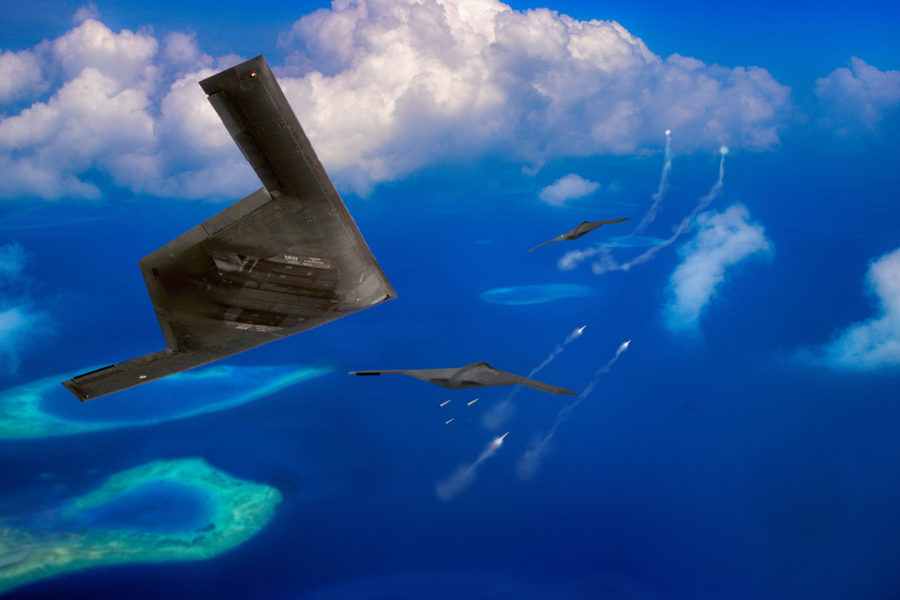The Air Force is accelerating the B-21 program, Northrop Grumman President and Chief Executive Officer Kathy Warden told reporters on a quarterly earnings call. The Air Force apparently permitted Northrop to discuss more of the highly classified program’s progress than in recent years.
Warden, talking with financial reporters April 28, said “the government is looking at layering” production of the Raider “on top of” its development phase. Despite the acknowledgement that the program is speeding up, production rates on the B-21 remain classified, she said. She noted that the B-21 effort has been successful enough to warrant a $67 million performance incentive fee for meeting an unnamed target in the first quarter.
Inflation has been playing havoc with other companies’ earnings because of fixed-price contracts, and to allay investor concerns, Warden also pointed out that while low-rate initial production of the B-21 is fixed-price, development is not.
Moreover, costs for full-rate production aircraft “have yet to be negotiated,” said David Keffer, Northop Grumman’s executive vice president and chief financial officer.
As for the production phase, “you can think of that as notionally around the ’25-’26 timeframe—he middle part of the decade,” Warden said.
Air Force budget documents released earlier in April show the Air Force will spend $20 billion to build B-21s over the five-year future years defense plan.
The LRIP phase will begin in 2023, Keffer said, “and run in parallel with the EMD [engineering and manufacturing development] for a period of time.” He didn’t say when EMD would be concluded. Warden later said she doesn’t expect a “peak year” when revenues from the two phases will overlap. The company expects steadily increased revenues from the B-21 franchise through the decade, she said.
Keffer said the company marked “a $67 million favorable adjustment on the B-21 program, related to performance incentives” in the first quarter.
The B-21 is “currently in its cost-type EMD phase, with a variety of incentive fees which we accrue based on anticipated achievement.” The program is now in “a critical integration and test portion of the EMD phase, … and we continue to focus on production efficiencies,” Keffer said.
Under the initial 2015 contract, LRIP will include 21 aircraft in five lots. Warden confirmed that the B-21’s cost will come in under the Air Force’s initial ceiling production unit cost of $550 million in 2010 dollars. The last time the Air Force officially re-set the figure was in 2019, she said, when it was “a little over $600 million” average procurement unit cost. Using the CPI escalation method from 2010, it would be $741.69 million today. That, however, is the fixed-price limit of the initial contract, and full-rate units will have more recent inflation factored in. Still, Warden said she expects inflation will “modulate” in coming years.
“We continue to expect production to be priced and profitably executed within the program’s average procurement unit cost target,” she said.
She noted that the Air Force has “confirmed that the first aircraft has entered the ground test phase, paving the way for first flight. And there are five additional aircraft in various stages of assembly.”
This progress “is partly enabled by our digital design capabilities and advanced manufacturing technologies, which reduce risk ahead of the aircraft’s first flight,” Warden said. “Looking forward, we expect sales on the B-21 program to grow, as the EMD phase [progresses] into low-rate initial production. This assumption underpins our expectations for aeronautics revenue to be flat next year and return to growth in 2024.”
Warden said the greater detail provided had to do with making sure inflation’s role in the program is understood.
“This is an important thing for us to touch on, and it’s why we provided a bit more clarity on what production looks like on the B-21 program, as we are approaching that phase.”
Warden said, “We did bid a set quantity. That quantity is not something I can share, but it is a small portion of the overall program of record, … and that was bid as fixed-price. And as we put that bid together, of course, we at the time laid in some expectations about growth in inflation to adjust to the time period.”
She said, “We will continue to look at whether those assumptions still hold. I’ll remind you, we’re not really going to be into the production phase for a couple of years, in any significant way, and so we still have a good bit of time, and we expect that inflation is going to modulate. And we’ve not seen—based on the assumptions we’ve made today—a material impact to the program.”
Northrop Grumman will work to make sure it “executes to those quantities profitably.”
Asked if she thinks the government will shift away from fixed-price contracts, Warden said, “I think we’ve already seen that.”
The Air Force has shifted its thinking on the B-21, initially saying it would build 80-100 of the aircraft, then 100, and of late “at least 100,” although Air Force Global Strike Command officials have said the likely requirement is on the order of 145 aircraft.
Air Force Secretary Frank Kendall has also set as an “operational imperative” the need to complement the B-21 with uncrewed aircraft that will escort it, providing electronic jamming, additional weapons, and likely defense suppression. No costs for that aspect of the program have been shared.
